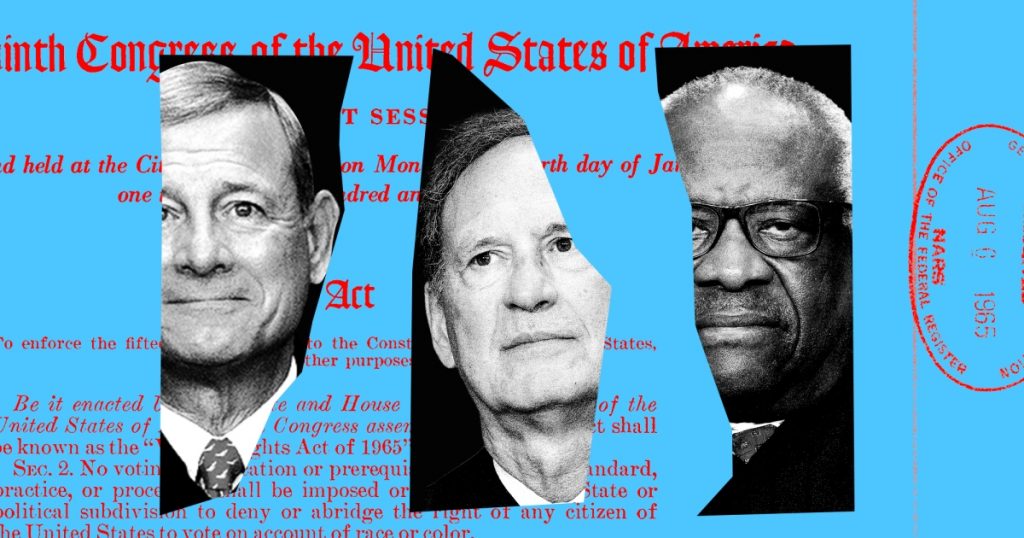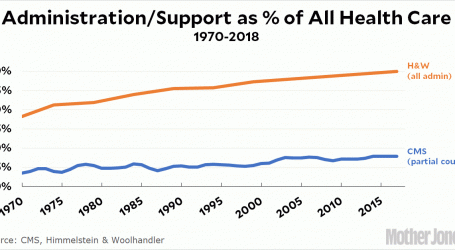Blame the Supreme Court for America’s Decade of Voter Disenfranchisement
Fight disinformation: Sign up for the free Mother Jones Daily newsletter and follow the news that matters.As a Black teenager growing up in Wilson, North Carolina, in the 1950s, Milton “Toby” Fitch Jr. wanted to swim in the Olympic-sized pool on the prosperous East side of town—a pool that only white people could use. Like so many places in the Jim Crow South, Wilson, a tobacco town of roughly 50,000 people one hour east of Raleigh, was heavily segregated; one study described it as two cities divided by a railroad track. One day, Fitch—whose father was the first Black mail carrier in Wilson and the North Carolina coordinator for Martin Luther King Jr.’s Southern Christian Leadership Conference—snuck in through the men’s showers and jumped in the pool. The police escorted him out and the city drained the water. “All the young kids were mad as hell at me,” he recalls.
In 1965, the monumental Voting Rights Act passed, striking down the suppressive devices that prevented African-Americans from voting in the South for so many years. At the time, one in four North Carolinians were Black but there wasn’t a single Black member in the state legislature. When Fitch tried to register to vote after the law’s approval, an election official threatened to make him recite the Declaration of Independence, an example of one of the many ways Southern white officials kept Blacks from voting. Fitch protested and succeeded in registering. “I realized and understood early on in life what people were able to achieve when they participated in the process,” Fitch tells me.
After becoming a civil rights lawyer in 1975, Fitch filed a range of lawsuits to desegregate schools, workplaces, and all levels of government in North Carolina. The latter effort finally bore fruit in the early 1980s when the courts ordered the state to create new legislative districts that would give Black voters the opportunity to elect their preferred candidates. Fitch joined the state house in 1985 and rose through the ranks, becoming the state’s first Black House Majority Leader and chair of the redistricting committee. He drew the map that led to the election of North Carolina’s first Black member of Congress since Reconstruction. After 16 years in the state house, he served as a state judge for 17 years, then rejoined the legislature as a member of the state senate in 2018.
Like so many prominent Black lawmakers, Fitch owed his political career to the Voting Rights Act. But last year, he became one of the victims of the Supreme Court’s gutting of the law. North Carolina Republicans passed a redistricting map in 2021 that took away two counties in his district carried by Joe Biden and added two counties carried by Donald Trump, reducing the number of Black voters from 48 percent to 35 percent. This meant that a once-secure Democratic seat shifted eleven points to the right, and Fitch lost handily to a white Republican. In total, seven Black members—a fifth of the state legislature’s Black caucus—lost their seats in 2022, leading to a stunning decline in minority representation in a state that had been regarded as one of the most integrated in the South.
The main reason that Republicans were able to target Black representation so ruthlessly was because of Shelby County v. Holder, a 2013 Supreme Court ruling holding that states with a long history of discrimination no longer needed to approve voting changes and electoral maps with the federal government—a process known as “preclearance.” June 25th marks the 10th anniversary of the decision, which has had a devastating impact on voting rights in the South. Shelby County laid the groundwork for a wave of new voter suppression laws and racially gerrymandered maps. Decades of advances for minority voters have been wiped out in the past ten years.
“History did not end in 1965,” Chief Justice John Roberts wrote in his majority opinion in the 5-4 ruling, alleging that “things have changed dramatically” in the South. But Ruth Bader Ginsburg’s fiery dissent, where she compared the decision to “throwing away your umbrella in a rainstorm because you are not getting wet,” now seems far more prescient.
“It’s pouring right now in the South,” says Hilary Harris Klein, a senior counsel for the North Carolina-based Southern Coalition for Social Justice. “Absolutely pouring.”
Since 2013, more than thirty states have passed new restrictions on voting, including 85 percent of states that were previously required to get federal approval for their voting changes, either statewide or in select jurisdictions. Twenty new laws impeding voting access and fair election administration were passed in the former preclearance states following the Shelby decision, according to an analysis by the Voting Rights Lab provided to Mother Jones.
The last redistricting cycle also marked the first without preclearance, leading civil rights groups to challenge maps for Congress or the state legislature in ten of eleven Southern states based on allegations that they discriminated against minority voters. At least 21 Black lawmakers lost their seats last year in the former Confederate states, according to a review by the Washington Post of data from the National Conference of State Legislatures.
Fitch’s loss—combined with a party switch by a former Democrat in the state house—gave Republicans a supermajority in the North Carolina legislature, allowing them to override vetoes by the state’s Democratic Gov. Roy Cooper on critical issues like abortion and voting rights. Republicans now have majorities in all of the South’s 26 legislative chambers aside from the Virginia Senate, and supermajorities in at least one chamber of the state legislature in every former Confederate state except for Georgia, Texas, and Virginia. The expulsion of two Black Democrats from the Tennessee House last April captured national attention, but it was simply the most blatant example of how Southern state legislatures have undercut minority voting rights in ways unseen since the Jim Crow era.
“Because of the makeup of Southern legislatures, they’re starting to act pre-1960s,” says Dan Blue Jr., the minority leader in the North Carolina Senate.
The history of the South shows how quickly gains and rights for formerly disenfranchised communities can be taken away. “From Reconstruction through to 1900, North Carolina elected 111 black legislators,” The Economist wrote last year. “For the next 68 years, it elected none.” That changed with the passage of the Voting Rights Act, but the steady progress made in the South since 1965 has been abruptly reversed by the Shelby decision.
The shockwaves from the decision were immediate. First came a cascade of new voter suppression laws—beginning in Texas. Within hours of the decision, Texas Republicans implemented a voter ID law that had previously been blocked by the Justice Department, which allowed someone to vote with a gun permit as valid identification but not a state-university-issued ID.
A few weeks later, North Carolina passed a sweeping rewrite of its voting laws that required strict voter ID, repealed same-day voter registration, and limited Sunday voting, which historically has been when Black churches hold Souls to the Polls voter mobilization drives. A federal appeals court later found that the measure targeted Black voters with “almost surgical precision” and blocked it in 2016.
A year after the Shelby decision, at least 10 of the 15 states that had areas covered by the preclearance requirement had introduced new measures limiting access to the ballot. By the 2016 presidential election, the first in 50 years without the full protections of the Voting Rights Act, 14 states had new voting restrictions in place, which helped elect Donald Trump by depressing Democratic turnout in critical swing states like Wisconsin that he narrowly won.
By 2018, states previously covered under the VRA had closed more than 1,600 polling places. In the two years before the 2018 midterms, voter roll purges in areas with a history of voting discrimination increased by 40 percent compared to areas not covered by preclearance.
Voter suppression efforts have only intensified since Trump attempted to overturn the 2020 election, with his Big Lie inspiring an unprecedented reversal of voting access. Since then, in what constitutes the largest rollback of voting rights since the end of Reconstruction, 33 states, mostly controlled by Republicans, have passed 109 bills restricting voting access and undercutting non-partisan election administration, according to the Voting Rights Lab. These efforts have been remarkably coordinated, with dark money groups like Heritage Action for America writing “model legislation” for state legislatures to make it harder to vote.
33 states have some type of voting restriction law on the map.
And once more, Southern states like Georgia and Texas that previously needed federal approval for their voting changes have passed many of the most sweeping bills. When Attorney General Merrick Garland announced a lawsuit against Georgia in June 2021 for its law containing 16 different provisions making it harder to vote, he said that were it not for the Shelby decision, “it is likely that SB202 would have never taken effect.”
GOP-controlled states have become increasingly brazen in targeting minority voters. The Texas legislature recently passed a bill abolishing the position of election administrator and giving the GOP-appointed secretary of state the power to take over election operations exclusively in Houston’s Harris County, the most populous blue county in the state, where people of color comprise a majority of residents.
Post-Shelby, such laws can only be challenged after the fact, through lengthy litigation before conservative-dominated courts. The burden of proof has shifted from those engaged in discrimination to those facing it. Instead of stopping a crime before it occurs, civil rights groups are forced to seek justice once the damage has been done. “It’s like driving on a highway where you know there’s no police and you can go as fast as you want,” says Michael Li, senior counsel in the democracy program at the Brennan Center for Justice.
After North Carolina Republicans had their voter suppression bill blocked by a court in 2016, they introduced a new bill in early June 2023 that would have much the same effect. It undercuts Election Day registration, gives voters less time to cast ballots by mail, and expands voter challenges. The legislation was inspired, at least in part, by conservative activist Cleta Mitchell, one of the architects of Trump’s effort to overturn the election.
That bill, along with another that strips the state’s Democratic governor from appointing a majority of members to state and county election boards and lowers the threshold needed to redo an election, cleared the state senate on Wednesday.
“Everything that has been an open, positive way for people to turn out,” Fitch says, “they want to wipe it away.”
After the onslaught of voter suppression laws, the second major blow from the Shelby decision was a raft of gerrymandered maps passed by nearly every Southern state.
Following the 2010 election, when Republicans made major gains at the state legislative level across the South, they passed new redistricting plans. The measures concentrated Black voters into as few districts as possible to knock off white Democrats and enshrine a system of racially polarized voting that would benefit their party for the next decade.
Having succeeded in defeating nearly all the white Democrats, Republicans used the last redistricting cycle to turn their majorities into supermajorities by reducing minority representation and dismantling majority-minority districts in ways that would have never passed muster under preclearance. They claimed they were drawing the districts “race-blind” by refusing to undertake studies of racially polarized voting or consider racial data that was previously required under the VRA.
Republicans either dismantled existing majority-minority districts in areas like Fitch’s in North Carolina or refused to draw new ones to keep pace with demographic changes in states like Texas. Nearly all of the Lone Star State’s growth over the previous decade came from minority residents, but maps passed by legislative Republicans increased the number of districts held by white Republicans.
“If preclearance still existed, this entire redistricting process would’ve looked really different,” notes Harris Klein from the Southern Coalition for Social Justice. “That’s true throughout the South.”
North Carolina is a microcosm for the lengths Republicans will go to gerrymander a state. The state supreme court struck down the GOP’s redistricting maps last year as illegal partisan gerrymanders. New Congressional maps were drafted by a panel of retired judges, leading to an even split in the state’s US House delegation. But the court allowed the legislature to draft new maps for the state legislature. The revised state house plan passed with bipartisan support, but the state senate map was criticized by Democrats and subsequently struck down by the court a second time after the 2022 election. By then it was too late for Fitch and other Black Democrats who lost their seats. “I really should be in the state senate right now,” he says.
Republicans flipped control of the state supreme court in 2022 and earlier this year the new conservative majority vacated the earlier rulings striking the congressional and state legislative maps. On the same day, the court also upheld a new voter ID law passed by North Carolina Republicans and another measure denying voting rights to people on probation or parole. Put together, Harris Klein says these “are all decisions that squarely show the targeting of Black voting power in the state.”
Now enjoying a green light from the court, North Carolina Republicans are planning to draw new redistricting maps later this summer, which could give them four new seats in the US House and supermajorities in the legislature for the next decade. The result? An impenetrable system of one-party rule.
“Now that there are no guardrails regarding political gerrymandering and they don’t respect any that might have existed regarding racial gerrymandering, it’s just the wild, wild West,” says North Carolina Senate minority leader Blue.
The Shelby decision did keep intact Section 2 of the VRA, which applies nationwide and prohibits voting changes and redistricting maps that discriminate against voters of color. But the Supreme Court’s conservative majority has been steadily trying to weaken that part of the VRA, too.
Roberts worked strenuously to limit the power of Section 2 as a young lawyer in Ronald Reagan’s Justice Department, writing upwards of 25 memos arguing that “violations of Section 2 should not be made too easy to prove, since they provide a basis for the most intrusive interference imaginable by federal courts into state and local processes.” Eight years after the Shelby decision, in 2021, Roberts joined the conservative justices in a ruling upholding new voting restrictions from Arizona that made it made it significantly harder to challenge laws that target minority voters under Section 2.
So it was more than a little surprising when Roberts wrote a 5-4 decision earlier this month striking down Alabama’s congressional map for racial gerrymandering and preserving what remained of the VRA. Roberts and Brett Kavanaugh joined with the three liberal justices in Allen v. Milligan to uphold a district court ruling finding that Alabama was compelled to draw a second majority-Black congressional district.
That decision could lead to similar majority-minority districts being drawn in Louisiana and Georgia, and possibly other Southern states like South Carolina and Texas. Democrats could gain anywhere from three to five new US House seats as a result, significantly boosting their chances of taking back the chamber in 2024. It might also hand civil rights groups the ammunition to reverse the decline in minority representation at the state legislative level.
But voting rights experts caution that the victory could be short-lived. Kavanaugh’s concurring opinion stated that “the authority to conduct race-based redistricting cannot extend indefinitely into the future,” which suggests that the court could do to Section 2 what it already has done to preclearance.
“Not having your house destroyed by the wildfire,“ Li says, “doesn’t mean it’s structurally sound.”
As it stands, what’s left of the VRA is no substitute for what the court dismantled. More than 3,000 discriminatory voting changes from 1965 to 2013 were blocked under preclearance. In contrast, Roberts noted approvingly in the Milligan case that there have been fewer than 10 successful Section 2 lawsuits brought since 2010. The chief justice might not have felt the need to eviscerate the VRA completely because he’s already succeeded in sufficiently weakening it.
Both the Shelby and Milligan cases originated in Alabama, but Roberts’ opinions in each struck a very different tone. In Shelby, the Chief Justice emphasized the progress made since 1965 to claim that key protections of the VRA were no longer needed; in Milligan, he argued that the prevalence of longstanding racial discrimination proved that the VRA had not outlived its usefulness. Roberts would never admit this, but one can read the Milligan opinion as a rejoinder to Shelby—and an acknowledgment of how wrong he was a decade ago.
This was never in doubt for Toby Fitch. When I ask him if he worries the South is moving backwards, he cuts me off.
“I don’t think we’re going backwards,” he says. “We’ve already gone backwards.”





